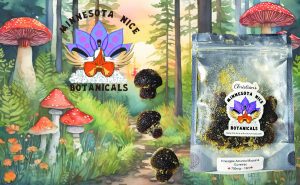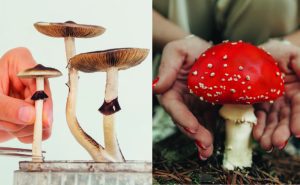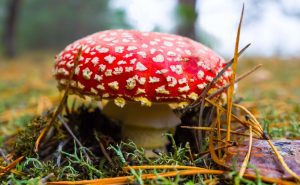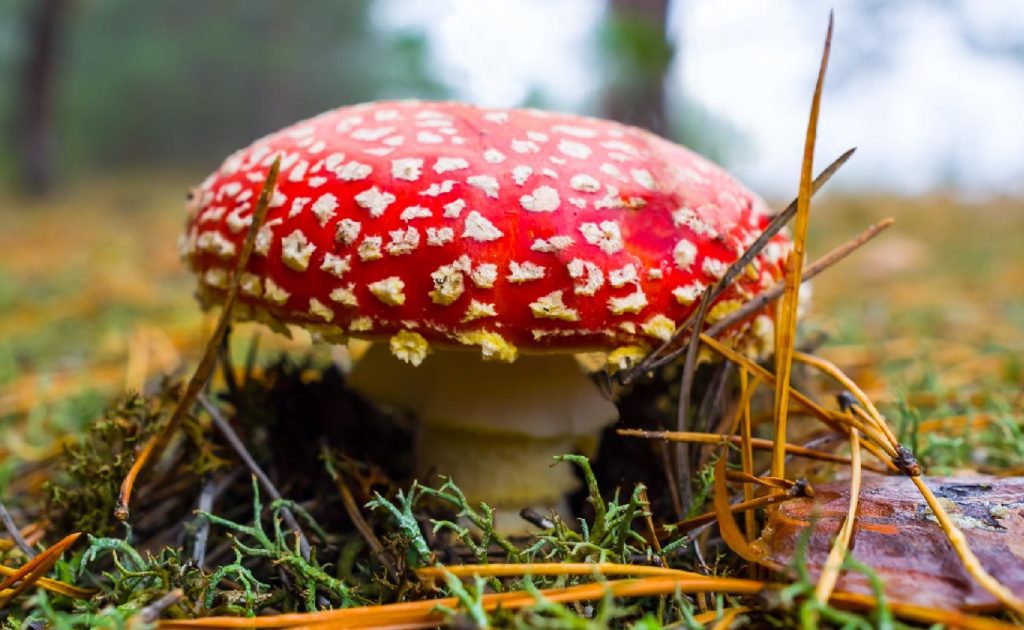
Amanita muscaria mushrooms, or the other Magic Mushroom, have captivated humankind with a striking red cap embellished with pristine white spots. Amanita muscaria mushrooms are now being investigated for their potential therapeutic advantages, including anxiety alleviation, enhanced sleep quality, and heightened empathy.
Beyond their medical applications, Amanita muscaria mushrooms serve as a recreational substance, containing psychoactive compounds like ibotenic acid and muscimol. Historical evidence of its recreational use can be traced to various regions in Europe, Russia, and Siberia, with Siberian traditions particularly renowned.
Join us as we explore this incredible mushroom!
Habitat / Geographical Information
Amanita muscaria is a prevalent fungus found worldwide, although it is most abundant in temperate and boreal climates. Amanita muscaria mushrooms grow in a mycorrhizal relationship with various tree species, mainly birch, pine, spruce, fir, and other conifers. Yet, they can also be discovered in other woodlands, meadows, and grassy areas. Depending on the climate, they can cluster together or form fairy rings, appearing from mid-summer to late autumn.
Amanita muscaria is a type of mushroom found in various regions across North America, from Alaska and Canada to the eastern United States [1]. It is also widely distributed in Europe, from Scandinavia to the Mediterranean, and in several regions of Asia, including Siberia and Japan [1]. This mushroom is very resilient and can thrive in different habitats. You can find Amanita muscaria mushrooms among deciduous and conifer woodlands in the temperate and boreal regions of the Northern Hemisphere. They can even be found in higher elevations of warmer latitudes in regions such as the Hindu Kush, the Mediterranean, and Central America. A recent molecular study suggests that it might have originated in the Siberian-Beringian region and spread outwards across Asia, Europe, and North America.
The season for fruiting varies depending on the climate. Fruiting typically occurs in summer and autumn across most of North America but later in autumn and early winter on the Pacific coast. This species is often found in locations similar to Boletus edulis and may appear in fairy rings. It has been widely transported into the southern hemisphere, including Australia [2], New Zealand [3], South Africa [4], and South America, where it can be found in the Brazilian states of Parana, Sao Paulo, Minas Gerais, and Rio Grande do Sul [1].
Amanita muscaria characteristics
Amanita muscaria’s characteristics are distinctive, setting them apart and making them easily recognizable.
- Cap
The mushroom typically displays a vibrant red or orange cap adorned with small, white, warty, or raised spots. When young, the cap is often convex, ranging in diameter from about 5-20 cm (2-8 inches), but as it matures, it becomes flat or slightly concave [5]. These mushrooms have a sturdy stalk or stem, usually white or pale yellow, and the cap can reach a height of up to 20 cm (8 inches). - Gills
Beneath its cap, Amanita muscaria characteristics are delicate white gills that gracefully extend from the center, accompanied by a white ring or annulus encircling the stem [5]. Not directly attached, these gills are either free or lightly connected to the stem. In its early stages, a veil may conceal the gills, sometimes as a ring of tissue encircling the stem. - Stalk
The stalk, known as the stipe, is delicate and whitish. Emerging from the plant’s base, it showcases a bulbous volva, resembling a cup-like structure encircled by shaggy rings of scales and a wide skirt [5]. - Spores
The spores of Amanita muscaria mushrooms are oval-shaped and have a white coloration.
Amanita muscaria characteristics are captivating and unforgettable. Its vibrant colors and unique features have made it a frequent muse in art and a significant cultural symbol.
Active Ingredients
Amanita muscaria, also known as the fly agaric, contains several essential compounds contributing to its unique properties. The two primary active ingredients are muscimol and ibotenic acid, psychoactive compounds that are responsible for the mushroom’s hallucinogenic effects. Additionally, it contains muscarine, a substance known for its toxic effects on the human nervous system [7].
Muscimol is a potent and selective agonist that targets GABA receptors with precision, leading to sedative, depressant, and hallucinogenic effects on the mind [8]. When consumed, muscimol stimulates GABAa receptors in different regions of the brain, such as the hippocampus, cerebral cortex, and cerebellum [6]. This interaction decreases the activity of the central nervous system, resulting in relaxation and possibly hallucinogenic effects. While muscimol causes a slight increase in serotonin, it is essential to note that this effect is relatively insignificant compared to the profound effects of classic psychedelics such as psilocybin and LSD. By acting as a GABAa receptor agonist, muscimol mimics the inhibitory neural effects of GABAa, which is the brain’s primary inhibitory neurotransmitter. Therefore, it can temporarily slow down nervous system activity.
Muscimol is the most potent psychoactive compound found in Amanita muscaria mushrooms, and it is responsible for their psychoactive effects. Its role as a GABAa activator or agonist gives muscimol sedative and soothing properties similar to a muscle relaxant [8]. However, unlike other sedative drugs, muscimol can induce hallucinogenic experiences at higher doses. It can affect hearing and taste, alter sensory perception, and produce vivid dreams. High doses of muscimol may result in euphoria, tranquility, a dream-like or lucid state of mind, out-of-body experiences, synesthesia (which means experiencing one sense through another), and often lead to falling asleep. Many people who consume Amanita muscaria mushrooms report experiencing visions and insights similar to those encountered in dreams.
Ibotenic acid, a neurotoxic compound found in Amanita muscaria, acts as a prodrug for muscimol. When dried, boiled, or ingested, ibotenic acid converts into muscimol. Excessive consumption of ibotenic acid can lead to hallucinations, confusion, vomiting, and nausea [9]. In severe cases, it may even induce seizures. When Amanita muscaria mushrooms are ingested or dried, the ibotenic acid can undergo decarboxylation, removing the carboxyl group (-COOH) and forming muscimol. Heat, drying, or the stomach’s acidic environment often triggers this decarboxylation process. Amanita products have gone through this decarboxylation process and are carefully formulated with minimal ibotenic acid and higher levels of muscimol to reduce these adverse side effects.
Ibotenic acid is the precursor to muscimol. Furthermore, ibotenic acid activates glutamate NMDA receptors, enhancing neural plasticity, learning, and memory. However, excessive stimulation from ingesting a large amount of ibotenic acid can cause adverse effects like confusion, delirium, gastrointestinal distress, sleepiness, and ataxia (drunken gait).
Typically, these symptoms will subside as the body converts the ibotenic acid to muscimol. However, this conversion should happen before ingestion through processing methods
Muscarine is a naturally occurring alkaloid in various wild mushrooms known for its psychoactive properties. While trace amounts of muscarine can be found in Amanita muscaria mushrooms, it’s important to note that this compound can have toxic effects in rare cases. These effects include excessive sweating, crying, salivation, and abdominal cramps [10]. To ensure safety, seek out Amanita products that have undergone laboratory testing to confirm the absence of this potentially harmful compound.
Muscarine acts as a neurotransmitter that activates muscarinic receptors in the cholinergic parasympathetic nervous system, also known as the “Rest and Digest’ system of the autonomic nervous system. In contrast, when activated, the “Fight or Flight” system releases stress hormones like adrenaline, dopamine, and cortisol. Muscarine can promote relaxation by activating the “Rest and Digest’ system. However, overactivation of the parasympathetic nervous system with high doses of muscarine can lead to adverse effects, such as a slowed heart rate and lowered blood pressure. This may cause weakness, dizziness, and fainting.
Consuming large amounts of unprocessed fresh or dried Amanita muscaria mushrooms can have adverse effects due to ibotenic acid and muscarin [7]. Therefore, consumers should exercise caution when self-administering and start with microdoses. It is also advisable for consumers to review the product’s third-party certified laboratory test results, specifically the Certificate of Analysis (COA), which indicates the levels of muscimol, ibotenic acid, and muscarine present in the product.

Therapeutic Uses
Derived from Amanita muscaria, muscimol has been utilized medicinally by tribal groups in Scandinavia, Eastern Europe, and Russia for centuries. As a GABAa agonist, modern medicinal chemistry and research support these traditional applications, demonstrating that muscimol can effectively address various mental and physical health concerns. These include alleviating stress and anxiety, relieving muscular pain, promoting restorative sleep, reducing insomnia, enhancing memory functions, and aiding in addiction recovery.
Studies on muscimol are currently in their early stages but have already displayed promising results.
Anxiety / Stress / Mood
Research on muscimol, the active compound in Amanita muscaria mushrooms, suggests potential for mood stabilization. A study by A.L. Gundlach and P.M. Beart in 1980 found that muscimol increased dopamine levels in rats [11]. Research also finds that low levels of muscimol slightly increase serotonin [12]. Muscimol’s sedative effects can also help calm the mind and body during a rise in stress.
Seizures / Tremors
Muscimol, the main active ingredient in Amanita muscaria mushrooms, is currently under review for its potential to help with seizures and tremors. Quoted from clinical research from August of 2012, “A muscimol concentration of 0.125 mM was well-tolerated and focally suppressed EEG activity.” [13]
Reduction In Pain / Inflammation
Recent research published in October 2023 has found the administration of muscimol causes a significant decrease in several neuropathic pain indicators, such as mechanical allodynia, mechanical hyperalgesia, and thermal hyperalgesia [14]. It’s also been found that muscimol protects against systemic inflammatory response in endotoxemic mice [15].
Memory / Brain Health
Additionally, research indicates that Amanita muscaria mushrooms containing muscimol may positively impact memory and brain health. This is particularly relevant for treating symptoms associated with conditions such as Huntington’s Disease and Alzheimer’s. A 2018 study found muscimol “exerted memory-enhancing and anti-inflammatory effects” [16].
How much should you take?
Amanita muscaria mushrooms present a distinct opportunity to delve into altered states and unlock therapeutic advantages, contingent upon the dosage. At psychoactive levels, Amanita muscaria has the potential to evoke euphoria and induce dream-like visions. In smaller doses, it can provide relief for sleep, pain, and anxiety-related conditions. Embrace the multifaceted properties of this mushroom for a comprehensive exploration of its potential benefits.
Microdosing Amanita Muscaria
If you’re struggling with sleep, pain, or anxiety-related conditions, taking a small to moderate dose of Amanita muscaria mushrooms might be helpful. According to anecdotal evidence, microdoses of muscimol, found in around 0.1 grams of dry, pre-packaged Amanita products or 100-250mg of muscimol extract, are the best choice for microdosing.
These small doses provide therapeutic effects without triggering more robust psychoactive qualities like hallucinations or perceptual alterations. Users often experience a warm and relaxed state characterized by euphoria, pain relief, relaxation, and sleepiness. These effects make Amanita muscaria a promising candidate for over-the-counter wellness solutions. Muscimol typically takes effect within an hour, peaks around three hours, and can last between 10 to 24 hours.
If you are not experiencing the effects you’re looking for, try slowly increasing your dose by 100-200 mg of muscimol extract at a time. Take time to note your feelings and experiences so you can determine the dosage level for you. Some people find a more moderate dose is best for them, at 300-500 mg of muscimol extract.
Psychedelic Dose of Amanita Muscaria
According to numerous experts, consuming muscimol doses above 550 mg can induce psychoactive effects. Surprisingly, 1 gram of dried Amanita products can contain this potency. Nonetheless, first-time consumers should start with a smaller dose.
Toxicity
Consuming unprocessed Amanita muscaria mushrooms can be extremely dangerous and poisonous. It is important to note that the toxic effects are primarily caused by compounds other than muscimol. Research indicates that the adverse side effects of Amanita muscaria are mainly attributed to ibotenic acid and muscarine. Fresh specimens of these mushrooms contain a significant amount of ibotenic acid, which acts as a potent neurotoxin. Excessive intake of ibotenic acid can result in various adverse effects, such as sweating, nausea, cramps, loss of balance, and involuntary bodily movements.
On the other hand, muscimol is well-tolerated when consumed as a purified extract from Amanita muscaria mushrooms with minimal ibotenic acid and muscarine content. Large doses of muscimol can still lead to undesirable effects, including headaches, nausea, vomiting, fatigue, dizziness, confusion, hallucinations, restlessness, and even coma.
Although muscarine is not found in significant quantities in Amanita muscaria, it can still contribute to concerns in rare cases of poisoning. Muscarine can also cause undesired effects such as blurred vision, increased salivation, and excessive sweating.
As mentioned earlier, producers of Amanita products should employ techniques that convert or “decarboxylate” the ibotenic acid to muscimol for efficacy and safety purposes. Fortunately, manufacturing processes can create a ratio of 90-to-1 or better of muscimol to ibotenic acid, reducing the impact of ibotenic acid effects. To ensure safety, consumers should seek muscimol extracts and products from reputable sellers that have removed or converted (decarboxylated) ibotenic acid to muscimol before consumption.
Amanita Muscaria Legal Status
Amanita muscaria mushrooms and their active ingredient, muscimol, are not included in the DEA’s controlled substances list, making it legally permissible to possess and distribute in the United States. Many reputable brands sell Amanita muscaria legally, including muscimol extracts, through online platforms.
On a state level, Louisiana is the only state that regulates muscimol under the Louisiana State Act 159. While muscimol is legal to purchase online and ship throughout most of the U.S., it is essential to note that the FDA, responsible for overseeing food ingredients, has not approved muscimol for consumption. Therefore, it’s best to only purchase from reputable brands that conduct rigorous testing to ensure product purity and potency.
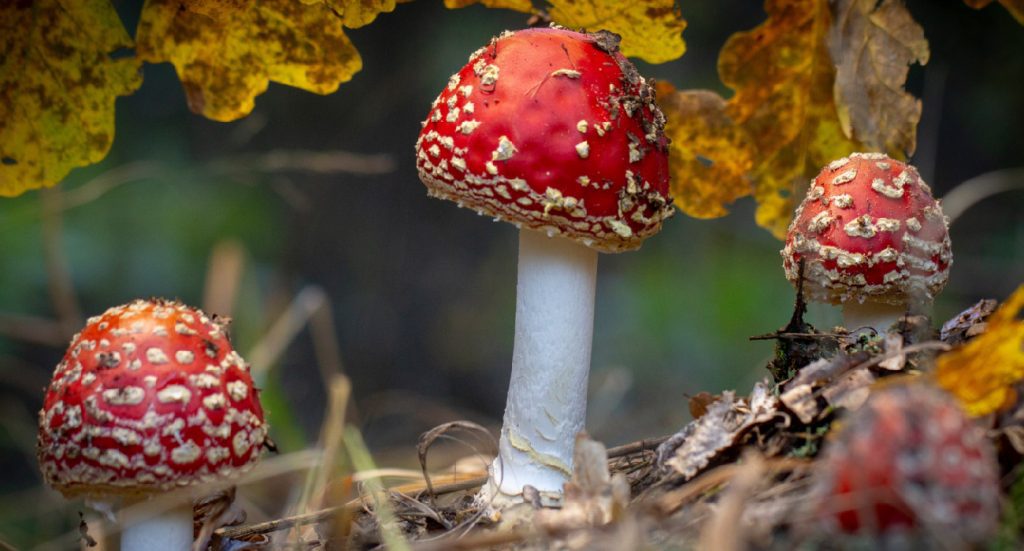
Ancient Uses
Ancient civilizations may have harnessed the medicinal properties of Amanita muscaria for shamanic rituals and healing purposes, as suggested by rock paintings depicting mushrooms and ancient statues resembling the fly agaric. Certain cultures in northern Europe and Asia still utilize this mushroom for its alleged anti-inflammatory properties, employing it to alleviate conditions such as depression, arthritis, and joint pain [17].
Amanita muscaria has various therapeutic uses in Siberia, such as a stimulant, analgesic, anti-inflammatory, anxiolytic, and sleep aid. Stories of mushroom inebriation emerged from explorers, soldiers, and prisoners of war in the 17th and 18th centuries, but the more subtle uses of the mushroom received less attention. This fantastic mushroom also has an interesting use as a stimulant, providing stamina and preventing fatigue. Siberian reindeer herders use dried fly agaric for strength and energy.
The Evensk and Koryak use Amanita muscaria as a poultice for pain and inflammation. Chuckchee women consume dried mushrooms to relieve muscle pain from tanning hides. Khanty and Koryak also use the mushroom to reduce anxiety and enhance courage. Singers among the Khanty and Koryak consume Amanita muscaria mushrooms to boost their performance.
The Rig Veda’s Veda’s Sanskrit hymns contain the earliest written evidence of using fungi for medicinal purposes. These ancient texts describe a ritual drink called “soma,” believed to confer divine powers upon those who drank it. This intoxicating elixir held great significance in ancient practices.
Ready To Try?
Amanita muscaria mushrooms are so fascinating! These mushrooms have been popular throughout the ages with their therapeutic potential and beautiful red-capped, white-spotted flesh. If you’re ready to explore this mushroom more personally, look at our The Ultimate Guide On Amanita Muscaria For Sale for some excellent Amanita product recommendations!

References
[1] Beringian origins and cryptic speciation events in the fly agaric (Amanita muscaria)
J. GEML, G.A. LAURSEN, K. O’NEILL, H.C. NUSBAUM and D.L. TAYLOR
https://web.archive.org/web/20110716142858/http://www.lter.uaf.edu/pdf/1190_Geml_Laursen_2006.pdf
[2] A Monograph of the Australian Species of Amanita Pers. ex Hook. (Fungi)
Derek A Reid
https://www.publish.csiro.au/BS/BT8008001
[3] A nomenclatural checklist of agarics, boletes, and related secotioid and gasteromycetous fungi recorded from New Zealand
Barbara P. Segedin &S. R. Pennycook
https://www.tandfonline.com/doi/abs/10.1080/0028825X.2001.9512739
[4] South African fungi: the genus Amanita
Derek A. Reid, Albert Eicker
https://www.sciencedirect.com/science/article/abs/pii/S0953756209813646?via%3Dihub
[5] Amanita muscaria wikipedia source
https://en.wikipedia.org/wiki/Amanita_muscaria
[6] Extrasynaptic δ‐GABAA receptors are high‐affinity muscimol receptors
Ali Y. Benkherouf, Kaisa‐Riitta Taina, Pratap Meera, Asko J. Aalto, Xiang‐Guo Li, Sanna L. Soini, Martin Wallner, Mikko Uusi‐Oukaricorresponding
https://www.ncbi.nlm.nih.gov/pmc/articles/PMC6438731/
[7] Amanita muscaria: Ecology, Chemistry, Myths
Quentin Carboué and Michel Lopez
https://www.mdpi.com/2673-8392/1/3/69
[8] Muscimol Compound Summary
https://pubchem.ncbi.nlm.nih.gov/compound/4266
[9] Ibotenic acid Compound Summary
https://pubchem.ncbi.nlm.nih.gov/compound/1233
[10] Muscarine Compound Summary
https://pubchem.ncbi.nlm.nih.gov/compound/9308
[11] Effect of muscimol on dopamine metabolism of the rat hypothalamus
A L Gundlach, P M Beart
https://pubmed.ncbi.nlm.nih.gov/7449921/
[12] Monoamines in the brain under the influence of muscimol and ibotenic acid, two psychoactive principles of amanita muscaria
P. König-Bersin, P. G. Waser, H. Langemann & W. Lichtensteiger
https://link.springer.com/article/10.1007/bf00402378
[13] Convection-Enhanced Delivery of Muscimol to the Epileptic FocusHeiss, John D. MD; Walbridge, Stuart BS; Rene’ Smith, RN BSN; Sato, Susumu; Oldfield, Edward H. MD; Lonser, Russell R. MD
https://journals.lww.com/neurosurgery/abstract/2012/08000/174_convection_enhanced_delivery_of_muscimol_to.132.aspx
[14] Muscimol as a treatment for nerve injury-related neuropathic pain: a systematic review and meta-analysis of preclinical studies
Hamzah Adel Ramawad, Parsa Paridari, Sajjad Jabermoradi, Pantea Gharin, Amirmohammad Toloui, Saeed Safari, Mahmoud Yousefifard
https://www.epain.org/journal/view.html?doi=10.3344/kjp.23161
[15] The protective effect of muscimol against systemic inflammatory response in endotoxemic mice is independent of GABAergic and cholinergic receptors
Ya-Hui Li, Dur-Zong Hsu, Chuan-Teng Liu, Victor Raj Mohan Chandrasekaran, Ming-Yie Liu
https://pubmed.ncbi.nlm.nih.gov/35856422/
[16] Very low doses of muscimol and baclofen ameliorate cognitive deficits and regulate protein expression in the brain of a rat model of streptozocin-induced Alzheimer’s disease
Vladimirs Pilipenko, Karina Narbute, Ulrika Beitnere, Juris Rumaks, Jolanta Pupure, Baiba Jansone, Vija Klusa
https://pubmed.ncbi.nlm.nih.gov/29133125/
[17] Religious use of hallucinogenic fungi: A comparison between Siberian and Mesoamerican cultures
HARRl NYBERG
https://web.archive.org/web/20180515183752/http://www.funga.fi/Karstenia/Karstenia%2032-2%201992-4.pdf
Kyrin Nguyen
Kyrin is a talented writer with experience contributing to websites in the cannabis and psychedelic, news, and medical industries. He has a remarkable ability to truly captivate readers. In addition to writing, Kyrin possesses a strong passion for bass guitar, guitar, MMA, and overall fitness.






